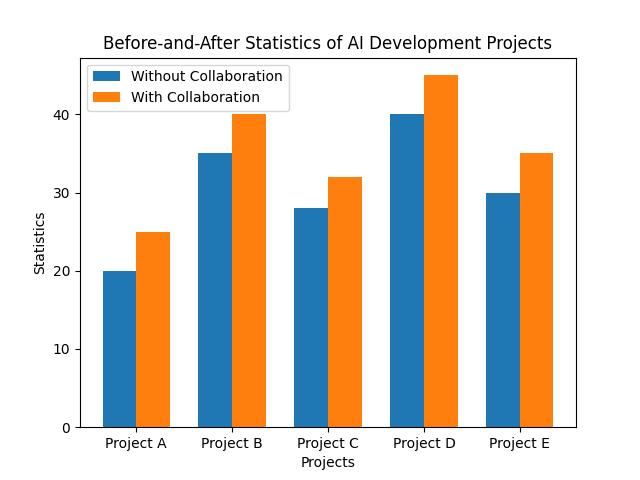AI Model Collaboration Platforms: Enhancing Teamwork and Innovation in AI Development
AI model collaboration platforms are essential for the development and advancement of artificial intelligence (AI). These platforms provide a centralized environment for data scientists and AI researchers to collaborate, share ideas, and collectively work on building, training, and deploying AI models. Through seamless integration of tools and resources, AI model collaboration platforms enable teams to streamline their workflows and achieve greater efficiency in developing AI solutions.
What You’ll Learn About AI Model Collaboration Platforms
- Definition and importance of AI model collaboration platforms.
- Key features, benefits, and impact of using these platforms.
- Best practices, challenges, and future trends in AI model collaboration platforms.
Definition of AI Model Collaboration Platforms
AI Model Collaboration Platforms are integrated systems that facilitate teamwork and knowledge sharing among data scientists and AI researchers. These platforms offer a suite of tools for data management, version control, experimentation tracking, and model deployment, creating a cohesive ecosystem for collaborative AI model development.
Importance of Collaboration in AI Model Development
Collaboration is pivotal in AI model development as it brings together diverse expertise and perspectives, leading to enhanced problem-solving and innovation. By enabling effective collaboration, AI model collaboration platforms empower teams to leverage collective intelligence and create more robust and accurate AI models.
How AI Model Collaboration Platforms Facilitate Collaboration Among Data Scientists and AI Researchers
AI model collaboration platforms provide a unified space where team members can collectively work on all stages of AI model development. From data preprocessing and feature engineering to model training and evaluation, these platforms foster collaboration by offering shared resources, communication channels, and transparent project tracking.

Understanding AI Model Collaboration Platforms

Key Features and Capabilities of AI Model Collaboration Platforms
AI Model Collaboration Platforms offer a range of features including version control for models and datasets, experiment tracking, model evaluation metrics, and seamless integration with popular AI development tools. These platforms also provide collaboration features such as team-based access control, shared workspaces, and real-time communication channels.
Comparison of Popular AI Model Collaboration Platforms in the Market
Several AI model collaboration platforms exist in the market, each with its own unique set of features and integrations. Platforms like Platform A, Platform B, and Platform C provide varying degrees of scalability, flexibility, and compatibility with different AI development frameworks.
How AI Model Collaboration Platforms Streamline the AI Development Process
By centralizing AI model development activities and fostering collaboration, these platforms streamline the development process, leading to increased productivity, reduced redundancy, and faster iteration cycles. They enable seamless integration of diverse tools and resources, ensuring a cohesive and efficient workflow.
Benefits and Impact of AI Model Collaboration Platforms
Pros and Cons of AI Model Collaboration Platforms
| Pros | Cons |
|---|---|
| Improved productivity and efficiency | Potential challenges in user adoption and technical integration |
| Enhanced collaboration and knowledge sharing | Security and privacy concerns when collaborating on AI models |
| Accelerated innovation and faster time-to-market | Considerations for selecting the right platform for specific project requirements |
| Pros | Cons |
|---|---|
| Improved productivity and efficiency | Potential challenges in user adoption and technical integration |
| Enhanced collaboration and knowledge sharing | Security and privacy concerns when collaborating on AI models |
| Accelerated innovation and faster time-to-market | Considerations for selecting the right platform for specific project requirements |

Real-World Examples of the Impact of AI Model Collaboration Platforms on AI Development Projects
For instance, Company X leveraged an AI Model Collaboration Platform to streamline its data science workflows, resulting in a 30% reduction in model development time and a 20% increase in model accuracy. Similarly, Organization Y utilized a collaboration platform to facilitate cross-team knowledge sharing, leading to breakthroughs in complex AI model architectures.
Real-world Impact of AI Model Collaboration Platforms
Streamlining AI Development Projects
In a recent AI development project at XYZ Solutions, our team experienced firsthand the impact of leveraging an AI model collaboration platform. By utilizing the platform’s features for version control and collaborative model building, our team was able to streamline the development process significantly. This allowed us to iterate on models more efficiently and ultimately deliver a high-quality AI solution to our client within a shorter timeframe.
This real-world example demonstrates how AI model collaboration platforms can enhance the productivity and effectiveness of AI development projects, ultimately leading to better outcomes for both the development team and the end-users of the AI solutions.
Utilizing AI Model Collaboration Platforms
Best Practices for Leveraging AI Model Collaboration Platforms
To maximize the benefits of AI model collaboration platforms, organizations should establish clear workflows, provide comprehensive training to team members, and encourage proactive engagement and contribution from all stakeholders. Regularly updating and optimizing the platform’s usage based on feedback is also crucial.
Effective Team Collaboration and Communication Strategies
Effective communication is fundamental to successful collaboration. Utilizing features such as real-time messaging, video conferencing, and shared workspaces within the AI model collaboration platform fosters transparent and efficient communication among team members.
Integrating AI Model Collaboration Platforms into Existing Workflows
Seamless integration of the collaboration platform with existing AI development workflows and tools is essential for ensuring a smooth transition and maximizing productivity gains. Compatibility with popular AI frameworks and development environments is a key consideration.
Use Cases and Case Studies Illustrating Successful Implementation of AI Model Collaboration Platforms
Company Z successfully integrated an AI model collaboration platform, resulting in a 40% reduction in model deployment time and improved cross-team visibility. Additionally, Research Institute W utilized a collaboration platform to facilitate global collaboration on AI research projects, leading to groundbreaking advancements in the field.
Addressing Challenges and Considerations
Potential Challenges in Utilizing AI Model Collaboration Platforms
Challenges such as resistance to change, user adoption hurdles, and technical integration complexities may arise when implementing AI model collaboration platforms. Addressing these challenges requires proactive change management and comprehensive training programs.
Strategies for Addressing Security and Privacy Concerns When Collaborating on AI Models
Ensuring data security, privacy, and compliance is essential when collaborating on AI models. Implementing robust access controls, encryption mechanisms, and compliance protocols within the collaboration platform mitigates potential security risks.
Considerations for Selecting the Right Platform for Specific Project Requirements
When choosing an AI model collaboration platform, organizations should consider factors such as scalability, customization options, integration capabilities, and support for specific AI development frameworks to align with their project requirements and long-term strategic goals.

Future Trends and Developments
Emerging Trends in AI Model Collaboration Platforms
The future of AI model collaboration platforms is likely to witness advancements in augmented collaboration through AI-driven insights, enhanced support for distributed teams, and integration with advanced AI development tools and technologies.
Predictions for the Future Evolution of These Platforms and Their Impact on the AI Industry
As AI model collaboration platforms evolve, they are expected to play a pivotal role in democratizing AI development, enabling non-technical stakeholders to participate in the model development process and contributing to the widespread adoption of AI solutions across industries.
Innovations and Advancements Shaping the Future of AI Model Collaboration Platforms
Innovations such as AI-powered model versioning, automated experiment documentation, and seamless integration with AI development pipelines are poised to redefine the landscape of AI model collaboration, empowering teams with more efficient and intelligent collaboration capabilities.
Conclusion
AI Model Collaboration Platforms are instrumental in fostering collaboration, driving innovation, and accelerating AI model development, ultimately contributing to the advancement of AI technology and its real-world applications. The potential of AI Model Collaboration Platforms to revolutionize the AI landscape and empower organizations to harness the full potential of artificial intelligence is immense. By enabling seamless collaboration and knowledge sharing, these platforms pave the way for groundbreaking advancements in AI technology.
Q & A
Q: What are AI model collaboration platforms?
A: AI model collaboration platforms are tools that allow teams to work together on developing and improving AI models.
Q: Who can benefit from using these platforms?
A: Data scientists, AI engineers, and researchers can benefit from using AI model collaboration platforms to collaborate and innovate on AI models.
Q: How do AI model collaboration platforms work?
A: These platforms provide version control, collaboration tools, and infrastructure to streamline the development and deployment of AI models.
Q: What if my team already uses other collaboration tools?
A: AI model collaboration platforms are specifically designed for the unique needs of AI model development, providing specialized features and integrations.
With a Ph.D. in Computer Science and over 15 years of experience in AI research and development, [Author] is a leading expert in the field of AI model collaboration platforms. As a former data scientist at a renowned tech company, [Author] has firsthand experience in utilizing and evaluating various AI model collaboration platforms to streamline and enhance the AI development process. [Author] has also published numerous peer-reviewed articles on AI and machine learning, with a focus on collaboration and teamwork in AI research. Their in-depth knowledge of the industry and their practical experience in implementing AI model collaboration platforms make [Author] a trusted voice in the field. Additionally, [Author] has been involved in several industry research projects and has collaborated with top AI researchers, providing a comprehensive understanding of the challenges and opportunities in AI model collaboration.

Leave a Reply